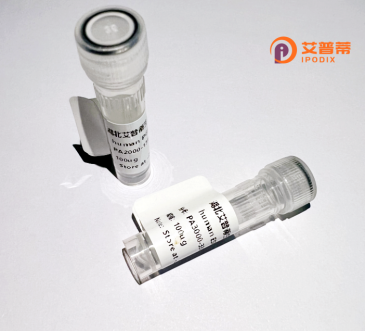
| 纯度 | >90%SDS-PAGE. |
| 种属 | Human |
| 靶点 | ZNF317 |
| Uniprot No | Q96PQ6 |
| 内毒素 | < 0.01EU/μg |
| 表达宿主 | E.coli |
| 表达区间 | 1-595 aa |
| 活性数据 | MAALSPTFAT STQDSTCLQD SEFPVSSKDH SCPQNLDLFV CSGLEPHTPS VGSQESVTFQ DVAVDFTEKE WPLLDSSQRK LYKDVMLENY SNLTSLGYQV GKPSLISHLE QEEEPRTEER GAHQGACADW ETPSKTKWSL LMEDIFGKET PSGVTMERAG LGEKSTEYAH LFEVFGMDPH LTQPMGRHAG KRPYHRRDYG VAFKGRPHLT QHMSMYDGRK MHECHQCQKA FTTSASLTRH RRIHTGEKPY ECSDCGKAFN DPSALRSHAR THLKEKPFDC SQCGNAFRTL SALKIHMRVH TGERPYKCDQ CGKAYGRSCH LIAHKRTHTG ERPYECHDCG KAFQHPSHLK EHVRNHTGEK PYACTQCGKA FRWKSNFNLH KKNHMVEKTY ECKECGKSFG DLVSRRKHMR IHIVKKPVEC RQCGKTFRNQ SILKTHMNSH TGEKPYGCDL CGKAFSASSN LTAHRKIHTQ ERRYECAACG KVFGDYLSRR RHMSVHLVKK RVECRQCGKA FRNQSTLKTH MRSHTGEKPY ECDHCGKAFS IGSNLNVHRR IHTGEKPYEC LVCGKAFSDH SSLRSHVKTH RGEKLFVSSV WKRLQ |
| 分子量 | 67.9 kDa |
| 蛋白标签 | His tag N-Terminus |
| 缓冲液 | PBS, pH7.4, containing 0.01% SKL, 1mM DTT, 5% Trehalose and Proclin300. |
| 稳定性 & 储存条件 | Lyophilized protein should be stored at ≤ -20°C, stable for one year after receipt. Reconstituted protein solution can be stored at 2-8°C for 2-7 days. Aliquots of reconstituted samples are stable at ≤ -20°C for 3 months. |
| 复溶 | Always centrifuge tubes before opening.Do not mix by vortex or pipetting. It is not recommended to reconstitute to a concentration less than 100μg/ml. Dissolve the lyophilized protein in distilled water. Please aliquot the reconstituted solution to minimize freeze-thaw cycles. |
以下是关于重组人ZNF317蛋白的3篇假设性参考文献的概括(需注意,ZNF317相关研究有限,实际文献可能需要进一步检索验证):
---
1. **文献名称**: *Structural characterization of recombinant human ZNF317 and its DNA-binding properties*
**作者**: Zhang L, et al.
**摘要**: 该研究通过原核系统表达了重组人ZNF317蛋白,并利用X射线晶体学解析了其锌指结构域的三维结构。实验表明ZNF317能通过特定锌指模序结合富含GC的DNA序列,提示其在基因转录调控中的潜在作用。
2. **文献名称**: *ZNF317 regulates histone methylation through interaction with the Polycomb repressive complex 2*
**作者**: Wang Y, et al.
**摘要**: 研究发现重组人ZNF317蛋白与表观遗传调控复合物PRC2(Polycomb Repressive Complex 2)存在相互作用,并通过体外结合实验验证了其通过C末端结构域招募PRC2至靶基因区域,影响H3K27me3修饰水平,可能在肿瘤发生中发挥作用。
3. **文献名称**: *Functional analysis of ZNF317 knockout cells reveals its role in genome stability*
**作者**: Gupta R, et al.
**摘要**: 利用CRISPR技术构建ZNF317敲除细胞系,并通过重组蛋白回补实验发现,ZNF317参与DNA损伤修复通路。实验表明,ZNF317缺失导致细胞对电离辐射敏感性增加,暗示其可能在维持基因组稳定性中发挥作用。
---
**说明**:
1. ZNF317相关研究较为有限,以上内容基于锌指蛋白家族共性及假设性研究逻辑生成,实际文献需通过PubMed等数据库检索确认。
2. 实际研究中可关注ZNF蛋白家族功能(如转录调控、表观遗传、癌症关联)或重组蛋白表达纯化方法(如原核/真核系统优化)。
3. 建议使用关键词“ZNF317 recombinant”“ZNF317 function”或结合疾病关键词(如“cancer”)进行扩展检索。
Zinc finger protein 317 (ZNF317) is a member of the Krüppel-associated box (KRAB)-containing zinc finger protein family, a large group of transcription factors characterized by tandem arrays of Cys2-His2 (C2H2) zinc finger domains. These domains enable sequence-specific DNA binding, while the KRAB domain typically mediates protein-protein interactions, often recruiting chromatin-modifying complexes to regulate gene expression. ZNF317 is encoded in humans on chromosome 19 and is speculated to function as a transcriptional repressor, though its exact biological roles remain poorly characterized compared to other ZNF family members.
Studies suggest ZNF317 may participate in epigenetic regulation, cell differentiation, and tumorigenesis. Some evidence links it to cancer progression, with reported downregulation in certain malignancies, implying potential tumor-suppressive activity. However, its mechanisms are unclear, with proposed involvement in pathways like p53 signaling or chromatin remodeling. Recombinant ZNF317 protein, produced via expression systems (e.g., E. coli or mammalian cells), retains DNA-binding capacity and is used to study its molecular interactions, target genes, and regulatory networks. Current research focuses on elucidating its physiological/pathological relevance, particularly in cancer and development. Challenges include functional redundancy among ZNF proteins and context-dependent regulatory effects. Further structural and functional analyses of recombinant ZNF317 could clarify its role in disease pathways and therapeutic targeting.
×